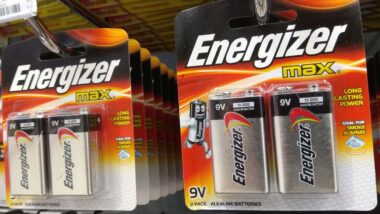Top Class Actions’s website and social media posts use affiliate links. If you make a purchase using such links, we may receive a commission, but it will not result in any additional charges to you. Please review our Affiliate Link Disclosure for more information.
In this chaotic time, it has become more clear than ever how important the safety of our health care workers is to the country’s overall safety. These selfless individuals go to work every day to help people, but unfortunately, they often come home sicker themselves.
A key component of the medical industry is keeping workers from getting the sicknesses of their patients, and disinfectant is indispensable for that purpose. However, sometimes it is the disinfectants themselves that do harm.
The Centers for Disease Control and Prevention published a blog in 2016 explaining the risks associated with one-step cleaners like OxyCide. The blog found that workers exposed to the cleaner commonly reported nasal problems, watery eyes, asthma-like symptoms, shortness of breath, and other concerns leading to the use of allergy medications.
In 2015, the Pittsburgh City Paper also reported on health problems caused by the cleaner that led hospital workers to file complaints with the Occupational Safety and Health Administration.
Relias Media provides background for the OxyCide controversy, noting that powerful cleaning products have been the source of much debate in the healthcare industry for a long time. The health issues that workers may face when dealing with chemicals has been one that hospitals have had to contend with long before OxyCide was released.
On the one hand, healthcare professionals rely on intense chemicals to handle dangerous bacteria. On the other hand, these same chemicals may very well pose a danger to workers who have to use them repeatedly during their work.
Specifically, strong chemicals have been needed to deal with Clostridium difficile, also known as “c. diff,” which has been resistant to efforts made to suppress it around the country. Its spores make it difficult to remove from the hospital environment. When OxyCide was touted as a solution to the c. diff problem, it quickly gained in popularity.
Now, the National Institute for Occupational Safety and Health has started researching the effects of Oxycide, an effort inspire by complaints field by workers at Pittsburg’s Magee-Women’s Hospital. The workers reportedly requested that a Health Hazard Evaluation be conducted.
The evaluation was conducted, and an interim report was produced determined that “exposure to OxyCide associated with adverse health effects and indicate the need to minimize employee exposure.” Of the workers who participated in the research by the Occupational Safety and Health Administration, around 44 percent of them had reported at least one work-related health issue that was reportedly consistent with complaints associated with OxyCide.
What Is the Occupational Safety and Health Administration?
The Occupational Safety and Health Administration (OSHA) is a regulatory body meant to “ensure safe and healthful working conditions” for people working in the U.S. by enforcing safety standards, providing training, doing outreach, and providing education and assistance. OSHA was put in place by Congress in 1970, but the head of OSHA reports to the Secretary of Labor, a member of the President’s cabinet.
Who Does OSHA Protect?
OSHA is meant to regulate the working conditions in most of the private sector and some of the public sector, as well. State and local government workers are not covered by OSHA, but federal workers are. Self-employed workers are also not under the jurisdiction of OSHA.
Geographically, the agency has jurisdiction over all 50 states and some territories. The OSHA website lists Puerto Rico, the Virgin Islands, American Samoa, Guam, Northern Mariana Islands, Wake Island, Johnston Island, and the Outer Continental Shelf Lands as the territories they cover.

Employees are guaranteed certain rights by OSHA: the right to a working environment that does not put them at risk of serious harm; the right to education about OSHA standards; the right to request information regarding the hazards in their workplace, and the ability to file complaints with OSHA.
OSHA Violations
Occupational Safety and Health Administration regulations cover a wide variety of industries with a wide variety of safety standards. Every year, OSHA releases a list of the ten standards most commonly violated by businesses in the previous year. According to Safety and Health Magazine, Fall Protection – General Requirements has been the most commonly violated standard for nine years in a row.
After Fall Protection, Hazard Communication, Scaffolding, and Lockout/Tagout violations make up the top four violations. Respiratory Protection, Ladders, Powered Industrial Trucks, Machine Guarding, and Personal Protective Lifesaving Equipment – Eye and Face Protection are the next most violated standards, from most to least, commonly violated.
Penalties for OSHA violations can reach $134,937 per violation in the case of willful or repeated violations. Serious and “other-than-serious” violations can carry fees of up to $13,494 per violation.
How to File an OSHA Complaint
Employees who feel they have been put in danger due to unsafe working conditions can file a complaint with the Occupational Safety and Health Administration. Filing a complaint is confidential and retaliating against an employee for exercising their right to file a complaint violates OSHA regulations.
If you feel you need to file a complaint, it’s recommended you do it as soon as possible after noticing the hazard. You can file a complaint online, via email, telephone, or in-person at your local OSHA office.
Join an OxyCide Class Action Lawsuit
An OxyCide class action lawsuit was filed against Ecolab Inc., manufacturer of OxyCide, on behalf of three plaintiffs who claim to have suffered injuries from using the defective and unreasonably dangerous disinfectant, according to AP News. The lawsuit is intended to represent hospital workers nationwide. AP reports that testing showed OxyCide contains known asthma-causing chemicals and immunosuppressive agents. The suit alleges that Ecolab refused to do similar testing themselves in order to determine the safety of its product.
A California worker filed a similar lawsuit in May. According to The Daily Hornet, Gretchen E., a hospital housekeeper, says beginning in 2017 she used Oxycide cleaner on the job. Shortly after first being exposed to the cleaner, Gretchen allegedly started to experience health problems including nose bleeds and coughing. Her coughing reportedly became more serious over the course of a couple of months, leading her to see a doctor. According to Gretchen, she was told to stop using OxyCide.
After alerting management to her concerns and symptoms, Gretchen says she learned that other employees reported experiencing similar issues.
“There have been numerous reports of employees developing serious health-related issues concerning OxyCide, including difficulty breathing, shortness of breath, nausea, vomiting, burning eyes, burning throat, bronchospasms, and/or vocal cord stridor,” the hospital Oxycide lawsuit alleges.
Other research has reportedly shown that long term exposure to OxyCide’s toxic chemical peracetic acid can lead to life-threatening complications such as liver problems, kidney issues, pulmonary edemas, and issues with circulation.
Like other plaintiffs, Gretchen claims that Ecolab hid the risk of OxyCide, leaving her and other healthcare workers unprepared for the consequences of exposure even after using the recommended safety instructions.
Individuals who developed health problems after using OxyCide may be able to join these plaintiffs in taking legal action. A lawsuit or class action against EcoLabs could help recover compensation for medical care and could even aid in protecting workers from future OxyCide-related harm.
The Hospital Oxycide Lawsuit is Case No. 0:20-cv-01126 in the U.S. District Court for the District of Minnesota.
Join a Free OxyCide Cleaner Side Effects Lawsuit Investigation
If you worked in a hospital that used OxyCide cleaning products and suffered side effects from exposure to the disinfectant, you may qualify to join a FREE OxyCide cleaner side effects lawsuit investigation.
Fill out the form on this page for more information.
This article is not legal advice. It is presented
for informational purposes only.
ATTORNEY ADVERTISING
Top Class Actions is a Proud Member of the American Bar Association
LEGAL INFORMATION IS NOT LEGAL ADVICE
Top Class Actions Legal Statement
©2008 – 2024 Top Class Actions® LLC
Various Trademarks held by their respective owners
This website is not intended for viewing or usage by European Union citizens.
Get Help – It’s Free
Join a Free OxyCide Cleaner Side Effects Lawsuit Investigation
If you qualify, an attorney will contact you to discuss the details of your potential case at no charge to you.
PLEASE NOTE: If you want to participate in this investigation, it is imperative that you reply to the law firm if they call or email you. Failing to do so may result in you not getting signed up as a client or getting you dropped as a client.
E-mail any problems with this form to:
Questions@TopClassActions.com.
Oops! We could not locate your form.













